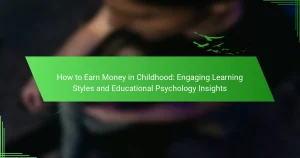Low expectations can severely impact student motivation, leading to decreased academic achievement. This article explores how low expectations diminish engagement and resilience, affect various learning styles, and contribute to a self-fulfilling prophecy. It also discusses effective strategies for educators to foster a supportive environment that promotes higher expectations and improved student outcomes.
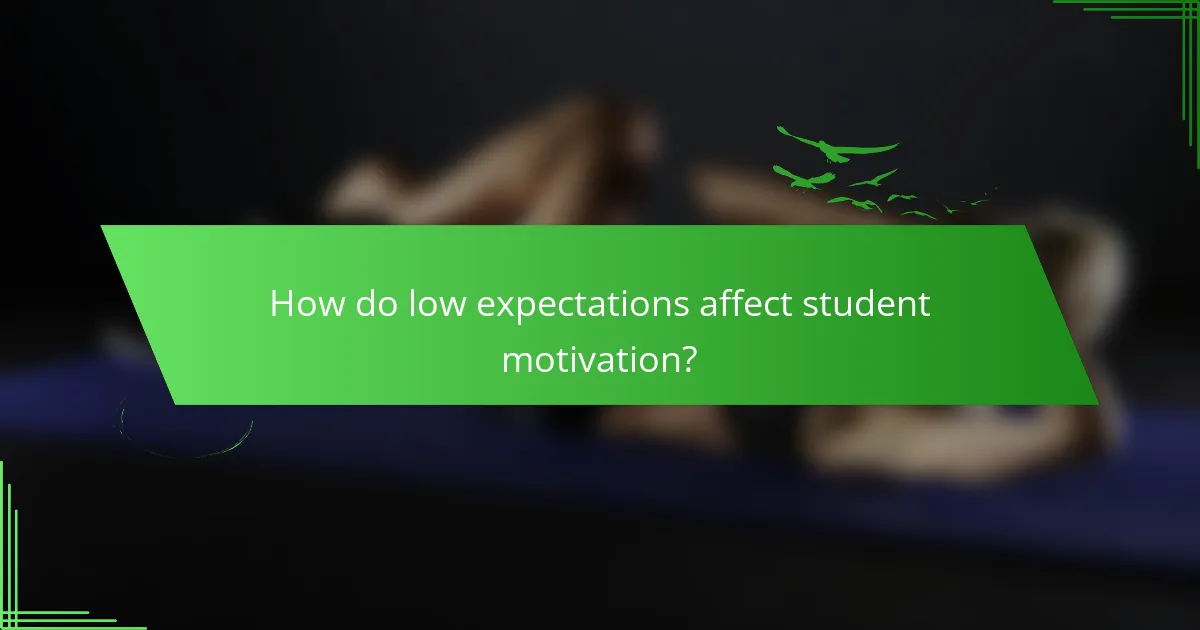
How do low expectations affect student motivation?
Low expectations significantly diminish student motivation, leading to lower academic achievement. When teachers or parents hold low expectations, students often internalize these beliefs, resulting in decreased effort and engagement. Research indicates that high expectations can foster a growth mindset, encouraging students to embrace challenges and persist despite difficulties. Conversely, low expectations can create a self-fulfilling prophecy, where students perform below their potential due to a lack of belief in their abilities. This cycle negatively impacts their learning styles, limiting their exploration of diverse strategies that could enhance their academic success.
What psychological theories explain the relationship between expectations and motivation?
Low expectations can significantly diminish student motivation and academic achievement. Psychological theories such as the Expectancy-Value Theory suggest that students’ motivation is influenced by their expectations of success and the value they place on the task. When students hold low expectations, their motivation declines, leading to disengagement and poorer learning outcomes. Additionally, the Self-Determination Theory emphasizes the role of intrinsic motivation, which can be undermined if students believe they cannot succeed. This interplay between expectations and motivation highlights the importance of fostering a positive learning environment to enhance academic performance.
What are the observable impacts of low expectations on student engagement?
Low expectations significantly reduce student engagement, leading to decreased motivation and poor academic performance. Students may disengage from learning, exhibit lower participation, and show a lack of interest in classroom activities. Research indicates that low expectations can create a self-fulfilling prophecy, where students internalize the belief that they are incapable of success. This mindset limits their willingness to explore diverse learning styles and hampers their overall academic achievement. As a result, fostering high expectations is crucial for enhancing student motivation and engagement.
How do low expectations influence classroom participation?
Low expectations can significantly hinder classroom participation. Students often feel demotivated when they believe their contributions are undervalued or that success is unattainable. This mindset can lead to disengagement and a lack of effort in academic tasks.
Research indicates that low expectations correlate with decreased academic achievement and limited learning styles engagement. When teachers underestimate students’ capabilities, it restricts their motivation to participate actively. Consequently, students may adopt a passive learning approach, further diminishing their academic performance.
Creating an environment that fosters high expectations can enhance student motivation and encourage diverse learning styles. This shift can lead to improved classroom dynamics and greater academic success.
What role does teacher feedback play in shaping student motivation?
Teacher feedback significantly influences student motivation by setting expectations and guiding learning. Constructive feedback fosters a growth mindset, encouraging students to engage with challenges. Research shows that positive reinforcement can enhance self-efficacy, leading to improved academic achievement. Conversely, low expectations can diminish motivation, causing disengagement and underperformance. Effective feedback aligns with individual learning styles, making it a unique attribute that can tailor support and boost motivation.
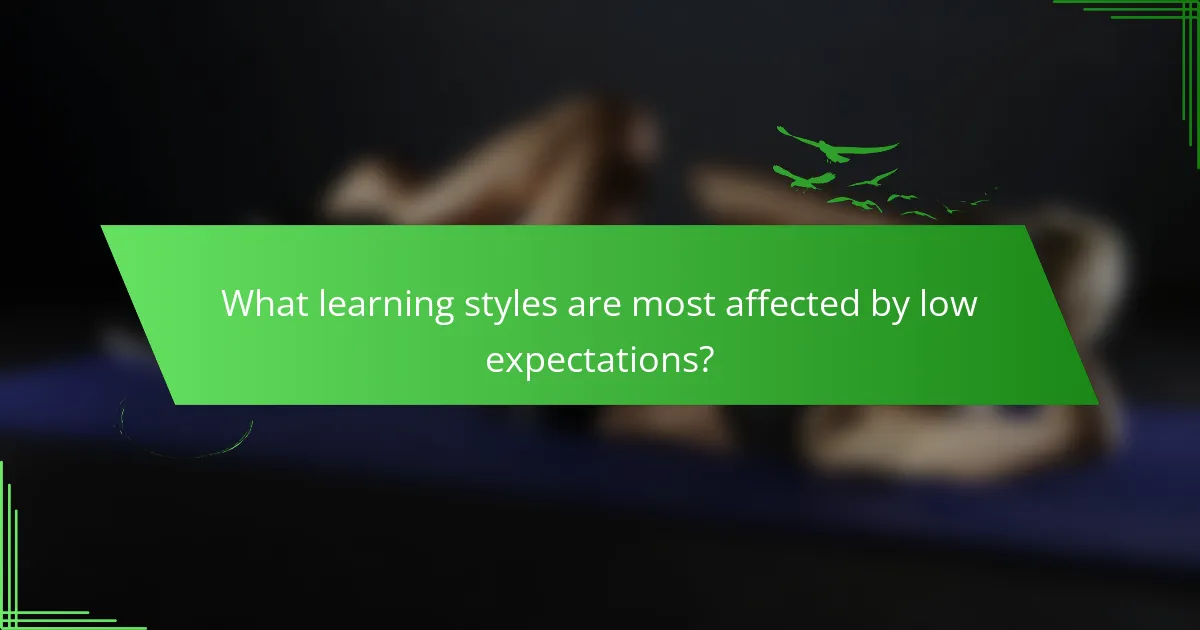
What learning styles are most affected by low expectations?
Low expectations adversely affect all learning styles, particularly those reliant on active engagement and interpersonal interaction. Students with kinesthetic and social learning styles often struggle more, as low expectations diminish their motivation and participation. This leads to reduced academic achievement and a lack of confidence in their abilities.
How do different learning styles perceive and respond to low expectations?
Students with different learning styles respond variably to low expectations, often leading to decreased motivation and engagement. Visual learners may struggle to connect when expectations are not clearly communicated, while auditory learners might feel disheartened by a lack of verbal encouragement. Kinesthetic learners often require hands-on experiences; low expectations can hinder their active participation. Research shows that low expectations can diminish academic achievement across all styles, reinforcing a cycle of disengagement. Tailoring approaches to individual learning styles can help mitigate the negative impacts of low expectations.
What are the unique challenges faced by auditory learners under low expectations?
Auditory learners face significant challenges under low expectations, including decreased motivation and engagement. These learners thrive on verbal instruction and feedback, which diminishes when expectations are low. Consequently, they may struggle to develop effective study habits and critical thinking skills, leading to lower academic achievement. Additionally, the lack of encouragement can hinder their ability to participate actively in discussions, further isolating them from collaborative learning experiences.
How do visual learners react to low expectations in academic settings?
Visual learners often struggle with low expectations in academic settings, leading to decreased motivation and engagement. These students thrive on visual aids and interactive learning, which are often overlooked when expectations are low. As a result, their academic achievement may suffer due to a lack of stimulation and affirmation. Research indicates that high expectations can enhance visual learners’ performance, fostering a more supportive learning environment that recognizes their unique attributes. Providing visual support and positive reinforcement can significantly improve their motivation and overall success in academic pursuits.
What strategies can enhance visual learners’ performance despite low expectations?
Visual learners can enhance their performance despite low expectations by employing targeted strategies. Utilizing visual aids, such as diagrams and charts, can significantly improve comprehension. Incorporating multimedia resources, like videos and interactive simulations, caters to their learning preference. Group activities that encourage peer collaboration can foster motivation and engagement. Additionally, setting achievable goals can help build confidence, countering the effects of low expectations. Regular feedback on progress reinforces a positive learning environment, promoting academic achievement.
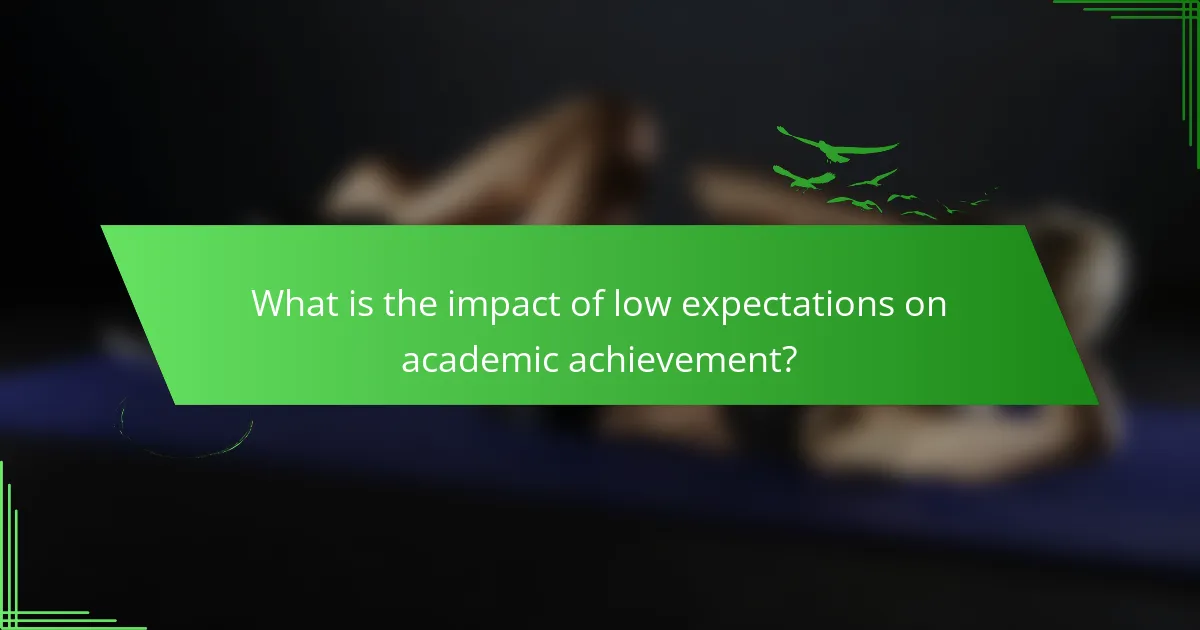
What is the impact of low expectations on academic achievement?
Low expectations negatively impact academic achievement by diminishing student motivation and engagement. When teachers or parents hold low expectations, students often internalize these beliefs, resulting in decreased effort and lower performance. Research shows that high expectations can enhance student outcomes, fostering resilience and a growth mindset. Consequently, addressing low expectations is crucial for improving educational success.
How do low expectations correlate with academic performance metrics?
Low expectations negatively impact academic performance metrics by reducing student motivation and engagement. Research shows that students who perceive low expectations are less likely to achieve their full potential. This correlation affects learning styles, leading to a passive approach to education. A study indicated that students with higher expectations from teachers performed significantly better, highlighting the importance of fostering a positive academic environment.
What are the long-term academic consequences of sustained low expectations?
Sustained low expectations lead to long-term academic consequences, including decreased student motivation and lower academic achievement. Students exposed to low expectations often develop a fixed mindset, believing their abilities are limited. This mindset hinders their engagement and willingness to tackle challenging tasks.
Research indicates that students with low expectations are less likely to participate in advanced courses or pursue higher education. The impact extends to learning styles, as these students may adopt passive learning approaches, further impeding their academic progress. Over time, this cycle reinforces negative self-perceptions and limits future opportunities for success.
In contrast, fostering high expectations can promote resilience and a growth mindset, enabling students to thrive academically. Schools and educators play a crucial role in setting these expectations, influencing student outcomes significantly.
How do socioeconomic factors influence the effects of low expectations on achievement?
Socioeconomic factors significantly shape the effects of low expectations on achievement. Students from lower socioeconomic backgrounds often face additional challenges, such as limited access to resources and support systems. These barriers can exacerbate the negative impact of low expectations, leading to decreased motivation and lower academic performance.
Research indicates that students in disadvantaged environments may internalize low expectations, resulting in a self-fulfilling prophecy. For example, a study found that low-income students are less likely to pursue higher education when faced with negative assumptions about their capabilities. In contrast, students from higher socioeconomic backgrounds may have more opportunities to counteract low expectations, such as access to mentorship and enrichment programs.
Overall, the interplay between socioeconomic status and low expectations creates a complex dynamic that can hinder academic achievement. Addressing these factors is crucial for fostering a more equitable educational landscape.
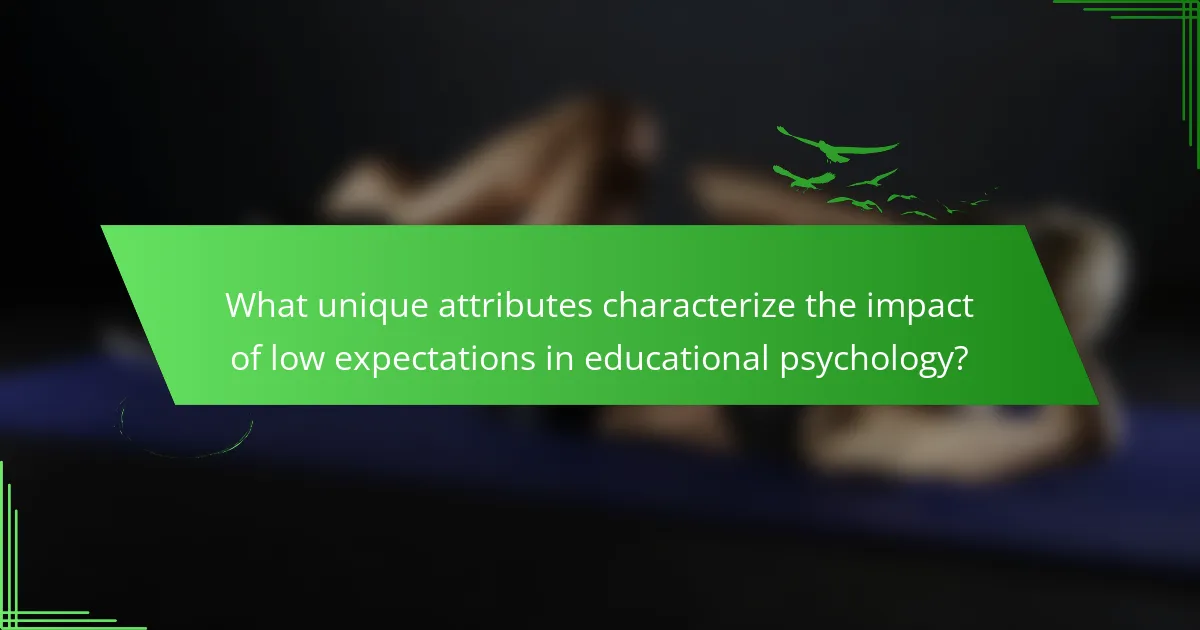
What unique attributes characterize the impact of low expectations in educational psychology?
Low expectations significantly hinder student motivation, learning styles, and academic achievement. These expectations can lead to a self-fulfilling prophecy, where students internalize low beliefs about their capabilities.
Unique attributes of this impact include reduced engagement, diminished resilience, and limited exploration of diverse learning styles. Students often adopt a fixed mindset, fearing failure, which stifles creativity and critical thinking.
As a result, academic achievement suffers, with students underperforming relative to their potential. Research indicates that high expectations from educators can enhance student outcomes, highlighting the importance of fostering a supportive learning environment.
Addressing low expectations requires targeted interventions, such as personalized feedback and growth mindset strategies, to empower students and improve their educational experiences.
How do cultural perceptions of expectations differ in educational contexts?
Cultural perceptions of expectations significantly influence student motivation, learning styles, and academic achievement. In cultures with low expectations, students often experience diminished motivation, which leads to underperformance.
Research indicates that students from backgrounds with high expectations tend to adopt more effective learning styles, resulting in better academic outcomes. For instance, a study found that students with supportive cultural frameworks achieved higher grades compared to those with low expectations.
Additionally, cultural attitudes shape how students perceive challenges. In environments where low expectations prevail, students may avoid risks, limiting their potential for growth. This underlines the importance of fostering a culture of high expectations to enhance student engagement and success.
Ultimately, addressing cultural perceptions of expectations can transform educational experiences, leading to improved motivation and achievement across diverse student populations.
What rare psychological phenomena can arise from low expectations in students?
Low expectations in students can lead to rare psychological phenomena such as learned helplessness. This occurs when students believe they cannot succeed, causing them to disengage from learning. As a result, their motivation declines, and they may exhibit passive learning styles. Research shows that these students often underperform academically, reinforcing their low expectations. This cycle can create a unique attribute of self-fulfilling prophecies, where expectations shape outcomes.
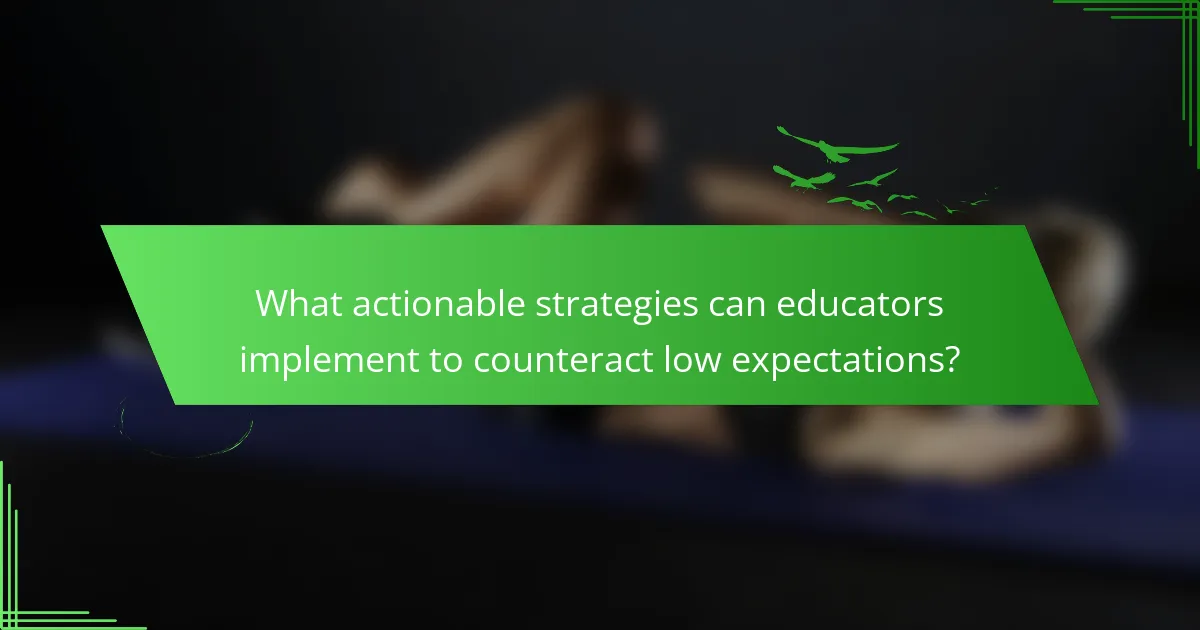
What actionable strategies can educators implement to counteract low expectations?
Educators can implement various strategies to counteract low expectations, enhancing student motivation and achievement. First, set high but achievable goals for all students. This encourages a growth mindset and fosters resilience. Second, utilize differentiated instruction to address diverse learning styles, ensuring that each student feels supported. Third, provide regular, constructive feedback to help students understand their progress. Lastly, create a positive classroom environment that celebrates effort and improvement, reinforcing the belief that all students can succeed.
What best practices can teachers adopt to foster a growth mindset?
Teachers can foster a growth mindset by setting high expectations, providing constructive feedback, and encouraging resilience. High expectations motivate students to strive for improvement. Constructive feedback helps students understand their progress and areas for growth. Encouraging resilience teaches students to embrace challenges and learn from failures. These practices enhance student motivation, cater to diverse learning styles, and ultimately improve academic achievement.
What common mistakes should educators avoid when addressing low expectations?
Educators should avoid underestimating students’ abilities, which can hinder motivation and achievement. Fostering a growth mindset is crucial. Focusing solely on standardized testing can neglect diverse learning styles. Ignoring individual student needs leads to disengagement. Lastly, failing to provide constructive feedback can diminish self-efficacy.
How can educators effectively communicate high expectations to students?
Educators can effectively communicate high expectations to students by clearly articulating goals and providing consistent feedback. Setting specific, measurable objectives enhances student motivation and academic achievement. Regularly acknowledging progress fosters a growth mindset, encouraging students to embrace challenges. Additionally, creating a supportive environment where students feel valued promotes engagement and persistence in learning.



